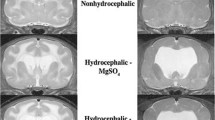Abstract
H-Tx rats produce congenitally hydrocephalic offspring with varying severity of the condition. We used moderately hydrocephalic rats without evident clinical signs of hydrocephalus and normal controls from the same stock when they were at least 1.5 years old. Macroscopic anatomy was studied by MRI and in fixed brain slices and the ultrastructure of the ependyma, with REM. Apart from markedly stretched areas, where the ependyma was totally destroyed and subependymal structures directly exposed to the CSF, the density of ependymal microvilli and of tufts of cilia was reduced in proportion to the ventricular distension of a given area. A supraependymal “network”– never seen before in acute hydrocephalus – was found, whose purpose is probably to prevent further ventricular enlargement. We conclude that even in arrested hydrocephalus the ependymal sequelae of hydrocephalus are similar to those of the acute stage, illustrating the extremely limited potenctial for recovery, but the organism seems nevertheless to react with an internal stabilization of the ventricular system.
Similar content being viewed by others
Author information
Authors and Affiliations
Additional information
Received: 8 January 1998
Rights and permissions
About this article
Cite this article
Kiefer, M., Eymann, R., von Tiling, S. et al. The ependyma in chronic hydrocephalus. Child's Nerv Syst 14, 263–270 (1998). https://doi.org/10.1007/s003810050222
Published:
Issue Date:
DOI: https://doi.org/10.1007/s003810050222




